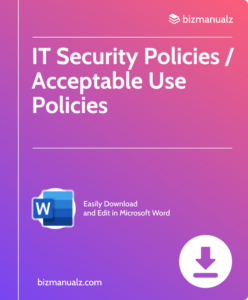CIO IT Governance and Risk Management

Welcome to the world of IT governance and risk management! If you are a business leader looking to protect your company from potential risks and maximize the effectiveness of your IT systems, then this article is for you. In today’s rapidly evolving technological landscape, it is crucial for organizations to have a well-designed governance and risk management framework. So, let’s unravel the mysteries of IT governance and risk management together.
What Is CIO IT Governance?
CIO IT governance frameworks ensure IT investments align with business goals and mitigate risks. This includes decision-making processes, resource allocation, and performance monitoring to maintain efficient IT operations.
To promote effective CIO IT governance, companies should establish clear communication channels between IT and business leaders, prioritize cybersecurity measures, and regularly evaluate IT performance in relation to strategic objectives.
What Are The Key Components Of CIO IT Governance?
The essential elements of CIO IT governance include:
- Defining distinct roles and responsibilities
- Implementing efficient communication strategies
- Aligning IT objectives with business goals
- Regularly evaluating and revising IT policies and procedures
Why Is CIO IT Governance Important?
CIO IT governance plays a crucial role in effective decision-making, risk management, and aligning IT with business objectives. It is essential for ensuring compliance, enhancing security, and optimizing resource utilization, all of which contribute to organizational resilience and growth.
How Does CIO IT Governance Impact An Organization?
- Enhanced Decision-Making: CIO IT governance ensures informed and strategic decision-making, aligning technology initiatives with business objectives.
- Improved Operational Efficiency: It streamlines processes, optimizes resource allocation, and fosters a culture of accountability and transparency.
- Risk Mitigation: Effective governance mitigates cybersecurity risks, data breaches, and regulatory compliance issues, safeguarding organizational assets and reputation.
How Does CIO IT Governance Impact An Organization?
- Enhanced Decision-Making: CIO IT governance ensures that decisions are well-informed and strategic, aligning technology initiatives with the organization’s business objectives.
- Improved Operational Efficiency: It streamlines processes, optimizes resource allocation, and promotes a culture of accountability and transparency.
- Risk Mitigation: Effective governance helps mitigate cybersecurity risks, data breaches, and regulatory compliance issues, protecting the organization’s assets and reputation.
What Are The Best Practices For CIO IT Governance?
Effective CIO IT governance is crucial for any organization to ensure the proper management and utilization of their technology resources. In this section, we will discuss the best practices for CIO IT governance, which are essential for maintaining a secure and efficient IT infrastructure.
We will cover the importance of establishing clear roles and responsibilities, implementing effective communication strategies, aligning IT goals with business objectives, and regularly reviewing and updating IT policies and procedures. These practices will not only mitigate risks but also promote organizational success.
1. Establishing Clear Roles And Responsibilities
Establishing clear roles and responsibilities in CIO IT governance involves:
- Defining the responsibilities of each team member clearly.
- Outlining the decision-making authority for each role.
- Communicating roles and responsibilities across the organization.
- Regularly reviewing and updating roles and responsibilities to align with organizational changes.
A company revamped its IT governance by clearly defining roles and responsibilities, leading to improved collaboration and efficiency across departments.
2. Implementing Effective Communication Strategies
- Establish a clear communication plan outlining the frequency and methods of communication for implementing effective communication strategies.
- Define the key stakeholders and ensure their involvement in the communication process for successful implementation.
- Use multiple channels such as emails, meetings, and reports to ensure effective dissemination of information and facilitate smooth communication.
- Encourage feedback and open dialogue to address any communication gaps and improve overall effectiveness.
Pro-tip: Leverage technologies like collaboration platforms for seamless communication and information sharing during the implementation process.
3. Aligning IT Goals With Business Objectives
Aligning IT goals with business objectives is crucial for organizational success. This can be achieved through:
- Evaluating business objectives and IT goals to identify any gaps in alignment
- Creating a strategic plan to realign IT objectives with current business needs
- Implementing regular reviews to ensure ongoing alignment between IT and business objectives
- Utilizing IT systems and processes to directly support and enhance business objectives
By aligning IT goals with business objectives, organizations can improve operational efficiency and drive overall business growth.
4. Regularly Reviewing And Updating IT Policies And Procedures
- Conduct a thorough review of existing IT policies and procedures to identify any outdated or ineffective practices.
- Engage relevant stakeholders and teams in the review process to gather diverse perspectives and insights.
- Update IT policies and procedures based on the latest industry standards, technological advancements, and organizational needs.
- Communicate the updated policies and procedures effectively across the organization to ensure widespread awareness and compliance.
Regularly reviewing and updating IT policies and procedures is crucial in maintaining operational efficiency, security, and alignment with evolving business requirements.
What Is Risk Management In CIO IT Governance?
Risk management in CIO IT governance is the process of identifying, assessing, and prioritizing potential risks in an organization’s IT infrastructure in order to minimize their impact.
This involves developing strategies to mitigate threats, ensuring compliance with regulations, and protecting the integrity and confidentiality of data. Regularly updating risk management protocols and working closely with relevant stakeholders can greatly improve the effectiveness of risk management in CIO IT governance.
What Are The Steps Involved In Risk Management?
- Identify risks: Determine potential risks that could impact IT operations and business objectives.
- Assess risks: Evaluate the probability and potential impact of each identified risk.
- Develop risk mitigation strategies: Create plans to minimize the impact of identified risks.
- Implement risk controls: Put in place measures to reduce the likelihood and impact of risks.
- Monitor and review risks regularly: Continuously assess and update risk management strategies.
In a similar tone, a company successfully mitigated a cyber threat by identifying risks, updating security protocols, and providing employee training. This demonstrates the importance of the steps involved in risk management.
Why Is Risk Management Important In CIO IT Governance?
The importance of risk management in CIO IT governance cannot be overstated. It is essential in mitigating potential threats, maintaining operational continuity, and protecting sensitive data. By identifying and addressing vulnerabilities, organizations can minimize the impact of cyber attacks, financial losses, and reputational damage.
The implementation of risk management strategies within CIO IT governance not only enhances decision-making but also ensures regulatory compliance and overall business resilience.
How Does Risk Management Help Manage IT Risks?
- Identifying and assessing risks: Begin by analyzing potential risks to IT systems and data security.
- Developing risk mitigation strategies: Create plans to minimize the impact of identified risks through preventive measures.
- Implementing risk controls: Deploy security protocols, access controls, and encryption techniques to manage and reduce IT risks.
- Monitoring and reviewing risks regularly: Continuously assess and update risk management strategies to adapt to evolving IT threats.
How Does Risk Management Help Manage IT Risks?
What Are The Key Elements Of A Successful Risk Management Strategy?
In today’s rapidly evolving technological landscape, risk management is a crucial aspect of any IT governance strategy. A successful risk management strategy involves a multi-faceted approach that encompasses identifying, assessing, and mitigating potential risks.
In this section, we will delve into the key elements of a successful risk management strategy, including the process of identifying and assessing risks, developing effective mitigation strategies, implementing risk controls, and regularly monitoring and reviewing risks. By understanding these essential components, organizations can effectively manage risks and ensure the security and stability of their IT systems.
1. Identifying And Assessing Risks
- Identify and assess potential risks within the organization’s IT infrastructure and processes.
- Evaluate the likelihood and potential impact of each identified risk.
- Engage relevant stakeholders to gather insights and perspectives on potential risks.
- Utilize risk assessment tools and methodologies to effectively evaluate and prioritize risks.
2. Developing Risk Mitigation Strategies
- Identify risks: Conduct a thorough assessment of potential risks within the organization’s IT infrastructure and operations.
- Assess impact: Evaluate the potential impact of each identified risk on the organization’s IT systems and overall business objectives.
- Developing Risk Mitigation Strategies: Create detailed plans to minimize the likelihood of occurrence and impact of identified risks.
- Implement controls: Put in place necessary controls and measures to execute the mitigation strategies effectively.
- Monitor and review: Continuously monitor the effectiveness of the risk mitigation strategies and review them regularly to adapt to changing circumstances.
3. Implementing Risk Controls
- Identify potential risks and vulnerabilities within the IT infrastructure.
- Develop and implement specific controls to mitigate and manage these risks effectively, in accordance with the guidelines for Implementing Risk Controls.
- Regularly monitor and assess the performance of implemented risk controls to ensure their effectiveness.
- Update and adapt risk controls to address new threats and changes in the IT environment, following the guidelines for Implementing Risk Controls.
Pro-tip: Collaborate with cross-functional teams to ensure comprehensive coverage and effectiveness of risk controls when implementing them.
4. Monitoring And Reviewing Risks Regularly
- Regularly review risk assessment results to ensure accuracy.
- Monitor risk indicators and warning signs, updating risk profiles accordingly.
- Conduct periodic audits of risk management processes to identify areas for improvement.
- Engage stakeholders in the review process to gather diverse perspectives.
Did you know that 4. monitoring and reviewing risks regularly is crucial for proactive risk mitigation and business continuity?
Frequently Asked Questions

What is CIO IT Governance?
CIO IT Governance is the process of establishing and implementing strategies, policies, and procedures to ensure that the information technology (IT) systems and processes support and align with the organization’s goals and objectives.
What does a CIO do in terms of IT Governance?
As the head of the IT department, the CIO is responsible for overseeing and managing the IT governance framework within the organization. This includes setting the IT strategy, defining policies and procedures, and ensuring compliance with regulations and standards.
What is the role of risk management in CIO IT Governance?
Risk management is an essential component of CIO IT Governance. It involves identifying potential risks and implementing measures to mitigate or manage them. This helps to ensure the security and resilience of the organization’s IT infrastructure and systems.
How does CIO IT Governance impact an organization?
CIO IT Governance plays a crucial role in the success of an organization. It helps to align IT initiatives with business objectives, improve decision-making processes, and ensure the efficient and effective use of technology resources. It also helps to reduce IT-related risks and compliance issues.
What are the key factors to consider when implementing CIO IT Governance?
Some of the key factors to consider when implementing CIO IT Governance include stakeholder involvement, clear communication, IT risk assessment, regular monitoring and review, and continuous improvement. These factors help to ensure that the IT governance framework is effective and sustainable.
How can organizations improve their CIO IT Governance?
Organizations can improve their CIO IT Governance by regularly reviewing and updating their IT policies and procedures, conducting comprehensive risk assessments, promoting a culture of compliance and accountability, and investing in IT governance training for employees. It is also essential to seek guidance from experts and stay updated on the latest trends and regulations in IT governance.

















Leave a Reply